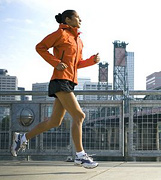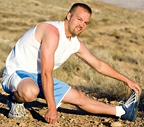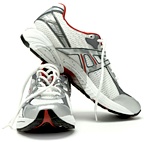Running for the Health of It
By Dr. Kevin M. Wong
The average person burns more than 500 calories per hour of moderate jogging. Whether you're a brisk walker or a marathon runner, these activities exert forces that can damage your feet. Wearing the right footwear and learning proper running technique can ensure your feet keep working for you.
Can you remember a time when you were particularly physically active? Think back to those days of elementary school and high school when much of your physical activity involved running in one form or another. For some of you, this enjoyment of running followed you into adulthood. The next time you are driving in your neighborhood, look around; you may be surprised to see how many people are out running.
Running has always been one of the most popular forms of exercise. It has many benefits including improved cardiovascular health, circulation and state of mind. However, it also is one of the prime activities that can cause significant damage to the human body. When patients come to my office for pain related to their love of running, they don't want to hear me say, "Stop running." This very well may be what they need, but they are looking to me for answers to help them stay in their sport.
 The physical act of running has different meanings to different people. Some of you may prefer walking with alternating spurts of running. You may like running at an easy or medium pace. You may prefer distance running. Regardless of your preference, there is an impact on your body, so take a moment to imagine these scenarios.
The physical act of running has different meanings to different people. Some of you may prefer walking with alternating spurts of running. You may like running at an easy or medium pace. You may prefer distance running. Regardless of your preference, there is an impact on your body, so take a moment to imagine these scenarios.
Picture yourself walking at a slow or comfortable pace. For the most part, during the walking cycle, one leg is swinging through the air and one leg is touching the ground. At one point, both legs touch the ground for a second or so (when the heel of one foot touches and the forefoot of the other takes off). Did you know that during regular walking, there are 5 G's of force that hit our heel with every step we take? That is a pretty significant amount of force, and that's just with walking. Also realize that when the force hits our heels, it doesn't stop there. It then moves across our feet to the toes and up into the ankles, knees, hips, lower back and to the upper body. Think of it as a force wave that goes from the ground upward.
 Now picture yourself walking as fast as possible. You progress from walking to a lightly paced jog to a medium-paced run and then to full-bore running. Do you understand that the force coming from the ground into the heels increases as you go from walking to running? The answer likely is yes, but let's put it into perspective. When we run, the force coming up to our heels from the ground is increased by three to four times our body weight. The harder the running, the more the force put onto our feet and our body. In other words, 5 G's of force coming into our heels with walking can become more than 20 G's with running.
Now picture yourself walking as fast as possible. You progress from walking to a lightly paced jog to a medium-paced run and then to full-bore running. Do you understand that the force coming from the ground into the heels increases as you go from walking to running? The answer likely is yes, but let's put it into perspective. When we run, the force coming up to our heels from the ground is increased by three to four times our body weight. The harder the running, the more the force put onto our feet and our body. In other words, 5 G's of force coming into our heels with walking can become more than 20 G's with running.
My goal for all of my patients is to keep them functioning at their highest level and allow them to perform whatever activities they choose to their fullest. Here is the framework and subsequent advice I give to all my runners. I hope it gives you some ideas that allow you to take care of your body so it takes care of you.
Start Slow, End Slow
 Stretching is an important part of most workout routines, running included. Unfortunately, stretching is the first thing that gets left out if you are in a hurry or you're trying to squeeze in your exercise for the day. You should be stretching before and after you run. Even five minutes of stretching before to warm up your muscles and five minutes of stretching after for a cooldown can prevent serious injury. I normally recommend 15-20 minutes of stretching to my patients before and after their workouts.
Stretching is an important part of most workout routines, running included. Unfortunately, stretching is the first thing that gets left out if you are in a hurry or you're trying to squeeze in your exercise for the day. You should be stretching before and after you run. Even five minutes of stretching before to warm up your muscles and five minutes of stretching after for a cooldown can prevent serious injury. I normally recommend 15-20 minutes of stretching to my patients before and after their workouts.
There are many different stretches. Regardless of which ones you choose to do, make sure you stretch into comfort and not pain. If a stretch is hurting, back off or don't do it. Pain is an indicator that something is wrong, and pushing past this point can invite injury to your door.
Since we all run at different paces, try the following protocol the next time you finish stretching. After stretching, begin walking at a slow, comfortable pace. After a few minutes, increase your pace gradually to a faster walk, then to a light jog and then into your full, usual running speed. Obviously, the time it takes you to get to a full run will vary, but it is a nice way of getting your body into the groove. Once you are almost finished with your run, gradually slowing your pace to a walk is a nice way to start your cooldown.

